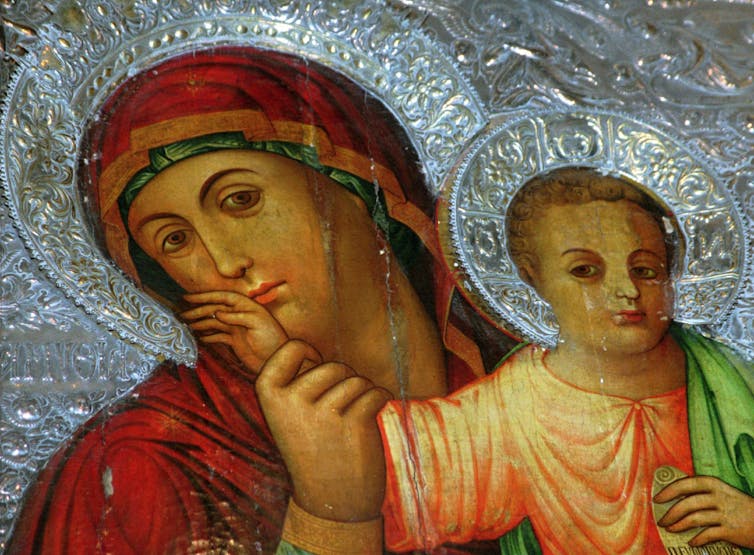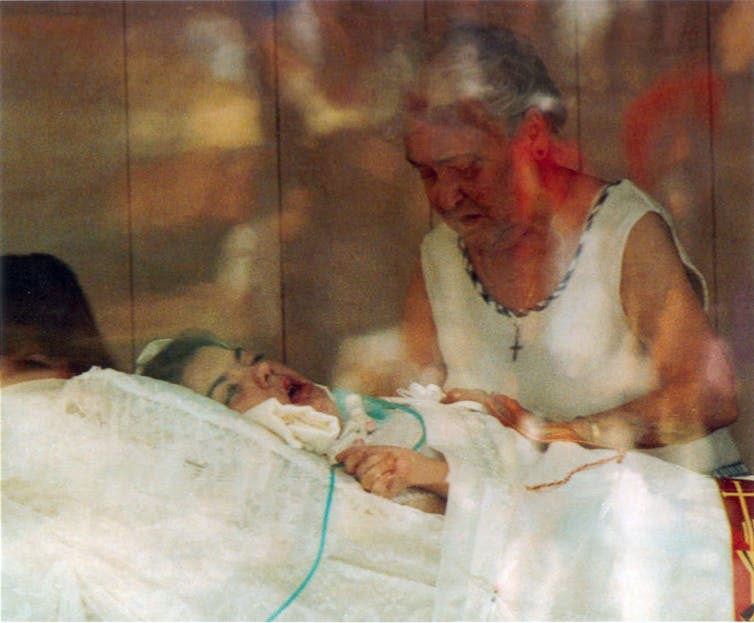What is behind belief in weeping Virgin Mary statues
- Written by Mathew Schmalz, Associate Professor of Religion, College of the Holy Cross
In a Catholic parish in Hobbs, New Mexico, a statue of the Virgin Mary has been “weeping[1].”
Onlookers have gathered out of curiosity, and also for prayer and healing. The liquid on the statue has been found to be olive oil and balsam[2] – the same mixture that is used for certain Catholic rituals after being blessed by a bishop.
Claims about supernatural phenomena, including weeping statues, have historically been common in Catholicism. A well-known example is the Madonna of Syracuse, Sicily[3], a plaster statue that has shed tears since 1953. Last year, in fact, weeping statues were reported in Hungary[4], Argentina[5] and Macedonia[6], just to name a few.
To understand why a weeping statue would be religiously meaningful, it’s first important to appreciate the connection between miracles and the Virgin Mary.
Miracles and Mary
Catholics believe Mary is the mother of Jesus Christ and, therefore, the mother of God.
Throughout Catholic history, supernatural events have been attributed to Mary’s power. When France’s Chartres cathedral burned, only Mary’s relic – called “The Veil of the Virgin[7]”– survived after being safeguarded by three priests who were miraculously preserved from the heat and flames.
Mary’s intercession is also believed to have ensured victory at the Battle of Lepanto[8] in 1571, when an Ottoman fleet was repulsed by the forces of Genoa, Venice and the papacy.
Mary’s tears have special significance for Catholics: She cries not only over the sins of the world, but also over the pain she endured in her earthly life, referred to as “the seven sorrows of Mary[9].” These sorrows, which include the crucifixion and death of Jesus, are depicted by seven swords piercing Mary’s flaming heart.
Even the flowery scent of olive oil and balsam evokes Mary since she is called “the rose without thorns[10].”
 The icon of Jesus and the Virgin Mary at Kykkos monastery in the Troodos mountains, where pilgrims gathered after reports of perfumed oily tears running from the eyes of both mother and child in 1997.
AP Photo/George Constantinou
The icon of Jesus and the Virgin Mary at Kykkos monastery in the Troodos mountains, where pilgrims gathered after reports of perfumed oily tears running from the eyes of both mother and child in 1997.
AP Photo/George Constantinou
It’s not surprising for a weeping statue of Mary to become an object of prayer and devotion.
And when this happens, the local bishop sometimes steps in to investigate.
The possibility of trickery
In examining claims of the supernatural, bishops are guided by standards set by the Vatican’s Congregation for the Doctrine of the Faith[11], which oversees Catholic doctrine. These standards primarily concern reports of “apparitions[12]” of the Virgin Mary. But the framework also applies to other supernatural occurences[13], including weeping statues. Perhaps because they address controversial issues, the standards were only made public in 2012[14] – nearly 35 years after they were first implemented.
The bishop, or a committee appointed by him, evaluates the supernatural phenonmenon’s impact on the community. Positive aspects can be healings and conversions, or even a more general deepening of faith among Catholics. Negative aspects would include sinful acts such as selling oil from a weeping statue or making claims contrary to Catholic doctrine.
One of the primary questions is whether the event has been staged. For example, in two cases of statues that wept blood – one in Canada[15] in 1986 and another in Italy[16] in 2006 – the blood turned out be that of the statue’s owner.
Liquids can be injected into the porous material of statues[17] and later seep out as “tears.” Oil that is mixed with fat can be applied to a statue’s eyes, which will “weep” when ambient temperatures[18] rise in the chapel.
In the case of the bronze statue of Mary in Hobbs, New Mexico, the investigation has uncovered no such trickery. But the fact that no cause has yet been found does not mean that a miracle has taken place.
The Catholic Church rarely endorses weeping statues and similar phenomena. Usually, a bishop or the Vatican will only go as far as saying that faith and devotion are more important than tales of supernatural happenings.
Searching for meaning
While understanding the phenomenon, it’s also important to appreciate the stories and individual motivations that people bring when they pray or worship in the presence of a statue that seems to weep.
 A special outdoor Mass was celebrated in honor of Audrey Santo, who was reputed to be connected to miracles, at the Holy Cross College stadium in Worcester, Mass.
AP Photo/Gail Oskin
A special outdoor Mass was celebrated in honor of Audrey Santo, who was reputed to be connected to miracles, at the Holy Cross College stadium in Worcester, Mass.
AP Photo/Gail Oskin
In my hometown of Worcester, Massachusetts, for example, statues and pictures have wept oil and blood at the home of the late Audrey Santo[19], who died in 2007 at the age of 23. As a child, “Little Audrey,” as she is still called, was left mute and paralyzed after a swimming pool accident. In spite of her physical condition, she was believed to pray for those who made pilgrimages to see her. After her death, a foundation was established[20] to promote her cause for sainthood. The statues and pictures weeping in her home were seen as signs that God had specially blessed Little Audrey’s life of suffering.
In my writings[21] about the case of Audrey Santo, I was tempted to focus on the stories of supernatural wonders. And the claims surrounding Little Audrey are still hotly debated[22]. In the end, I thought it would be more interesting to study how people find meaning[23] in phenomena like weeping statues.
At the Santo home, the people I talked to shared moving personal stories of pain and sadness, hope and healing. The sense of togetherness in and through suffering was far more important than talk of miracles.
In Worcester – as well as in Hobbs, New Mexico – I expect what is going on is much more than superstition.
References
- ^ weeping (www.kansascity.com)
- ^ olive oil and balsam (www.washingtonpost.com)
- ^ Madonna of Syracuse, Sicily (www.independent.co.uk)
- ^ in Hungary (www.youtube.com)
- ^ Argentina (www.dailymail.co.uk)
- ^ Macedonia (www.thesun.co.uk)
- ^ The Veil of the Virgin (sites.tufts.edu)
- ^ the Battle of Lepanto (www.wordonfire.org)
- ^ the seven sorrows of Mary (www.ncregister.com)
- ^ the rose without thorns (aleteia.org)
- ^ Congregation for the Doctrine of the Faith (www.vatican.va)
- ^ apparitions (www.catholic.org)
- ^ to other supernatural occurences (www.catholicnewsagency.com)
- ^ in 2012 (www.catholicnews.com)
- ^ Canada (www.apnews.com)
- ^ Italy (www.catholicnewsagency.com)
- ^ porous material of statues (www.religioustolerance.org)
- ^ ambient temperatures (www.nwitimes.com)
- ^ late Audrey Santo (www.telegram.com)
- ^ foundation was established (www.littleaudreysantofoundation.com)
- ^ writings (crossworks.holycross.edu)
- ^ hotly debated (web.archive.org)
- ^ how people find meaning (crossworks.holycross.edu)
Authors: Mathew Schmalz, Associate Professor of Religion, College of the Holy Cross
Read more http://theconversation.com/what-is-behind-belief-in-weeping-virgin-mary-statues-100358

